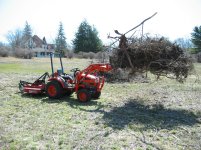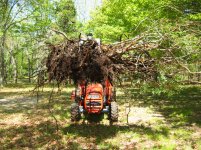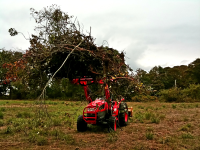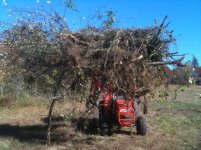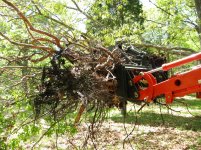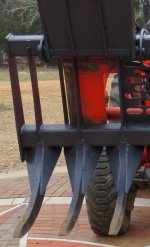1) Excavators use narrow grapples and do a perfectly fine job of moving large trees and rocks etc. I certainly agree we don't compare excavators to CUTs but the point is that a narrow grapple can grasp just about anything and certainly can grasp anything that a wider grapple can clamp on to.
2) In a perfect world where brush was exactly a certain density and uniform, it is certainly conceivable that a wider grapple could be more efficient at plowing through the brush and then clamping on a load. In the real world, there are often bigger sized bushes that require either working around or focusing on to uproot and a wider grapple is more of a disadvantage in that setting. Much is said about how a grapple as wide as the tractor will prevent brush from scraping along the tractor. I find with a 48" grapple and a roughly 68" wide tractor, that the ten inches on either side are almost never touched by brush. The reason is that the grapple sort of plows a "bow wave" ahead of the tractor and pulls out a lot of brush from either side. I have moved acres and acres of brush (in my case mostly brambles and wild blueberries or similar sized (6-8ft tall and wide and closely spaced) brush without issue. My technique is generally simply to open the grapple, put the tines an inch or two in the ground and drive forward in 4wd low until I lose traction. I then clamp and back out. Sometimes I will open and repeat the cycle with another bush before dumping the load just by compressing more into the grapple. In my neck of the woods, with a wider grapple I would be hitting those bushes off center and that is not good for the grapple or FEL. I can easily load enough into the grapple that I cannot see around it but the load is secure. Our brush is dense enough that I am almost never driving the full length of the tractor into the brush before filling the grapple. The combination of the "bow wave" and driving only ten or twelve feet forward each time means that no brush really touches the tractor even with a narrow grapple. If I were only clearing blackberries, which are easy to uproot, it is possible that I'd find a wider grapple more efficient but my brush is generally bigger so the narrower grapple works very well.
3) Agree that spacing between tines is important. I really like the idea of the removable intermediate tines on the EA small grapple. You really only need narrow spacing when dealing with rocks or firewood, otherwise wider (9-10") spacing is preferred IMO.
4) 85lbs extra isn't much but that 85lbs is far forward on the tractor so does cut your lift capacity at pivot pins by more than that. It also negates some of your rear ballast for traction purposes. Again, 85lbs isn't much but many guys are buying 72" grapples that weigh 200+lbs more than a light duty 48" grapple like mine. That has got to have an impact on performance.
5) The only way to really damage a grapple and FEL doing this sort of work is by A) shock loads from "bulldozing" or B) asymmetric loads. A wider grapple increases the odds of an asymmetric push against an unseen stump or rock and magnifies the torque such an event has on the FEL. I appreciate that grapples are pretty tough but there is no denying the physics and wider grapples are simply more vulnerable to damaging impacts.
6) I have yet to see anyone on TBN who bought a 48" grapple complain that they wished they'd bought a wider, heavier or more expensive grapple. A 48-50" size made in 3/8 mild steel with 1/4" frame tubing seems to stand up well even to the forces an
M59 can exert so I think it is an optimal size for most purposes. Again, if I was cleaning up construction debris, I'd want wider but for brush/tree removal and transport is seems perfect.

